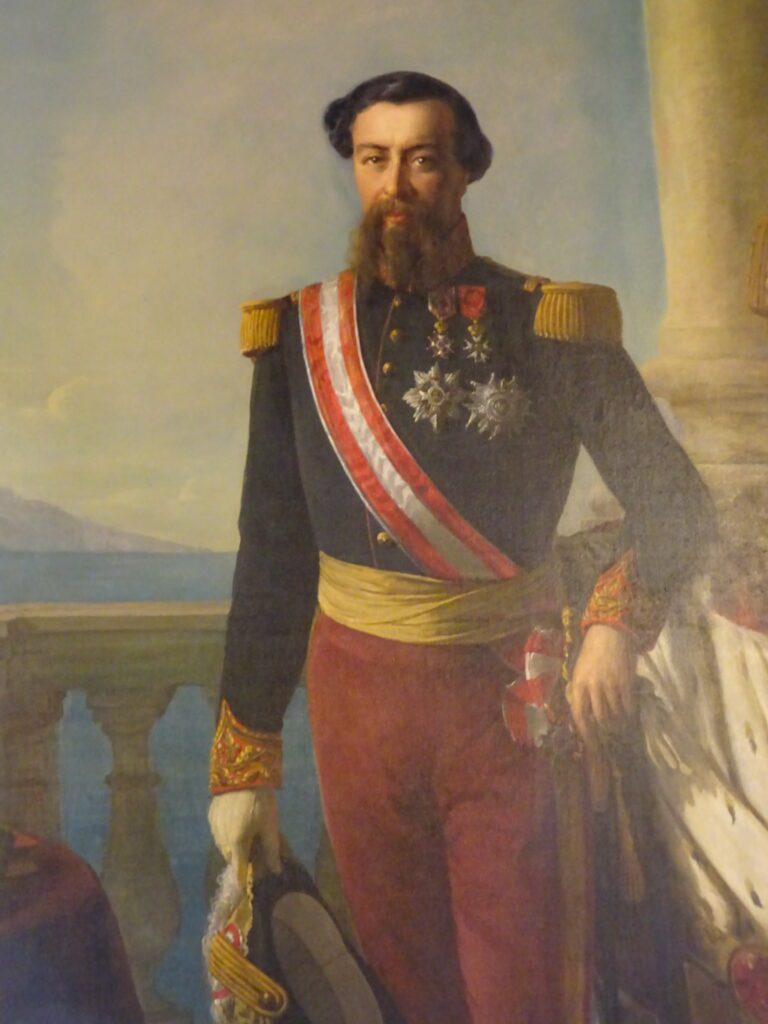Charles (Carlo) III succeeded his father Florestan. He was only 37 at the time and had been married for ten years to the Belgian countess Antoinette-Ghislaine de Mérode. They had a son, Albert. Charles was more involved than his father, perhaps under the influence of his mother Caroline, in developments in Monaco and had also interfered in the disguised split of Roquebrune and Menton.
He came to power at a politically turbulent time, in which the Kingdom of Sardinia – and especially King Vittorio Emanuele II and Prime Minister Cavour – increasingly harboured an ambition to achieve the Unification of Italy once and for all.
After secret negotiations in the French spa town of Plombières, an agreement was reached in 1859 between Cavour and Louis-Napoleon III to attack the Austrian territories on the peninsula, including Milan, Parma and Venice, together. In return for this aid, Sardinia ceded Savoy and Nice to France on March 24, 1860, with the Treaty of Turin. Referendums were held in these areas within a month to ensure that residents supported this decision. Sardinia also involved the people of the ‘villes libres’ Menton and Roquebrune in this referendum, as if these territories had already been appropriated by Sardinia.
Charles reacted indignantly, but Louis-Napoleon ignored the protests from the Principality. After the result, Monaco could no longer go anywhere, because Nice, Menton and Roquebrune voted overwhelmingly to join France. On July 17, 1860, King Victor-Emmanuel II also agreed to France taking over the protection of Monaco from Sardinia. He ordered his troops to withdraw from Monaco, Roquebrune and Menton, making the French takeover physically visible.

Charles III now had no other choice but to reach an agreement with Louis-Napoleon and accept his claim to Roquebrune and Menton. After some negotiations, the two heads of government agreed that both ‘villes libres’ would be transferred to France. In fact, the Principality was amputated from all its limbs, leaving only the trunk. Monaco retained only 1/16th of the territory and 1/7th of the population. In addition, the country saw its main sources of income, such as the sale of citrus fruits and olive oil, disappear on the other side of the new border. Monaco was poorly accessible by some barely maintained sandy paths from Menton.
Louis-Napoleon granted Charles the right for his Principality to exist and offered four billion francs as compensation for this enormous loss. He also promised that roads to Monaco would be built and that the yet-to-be-built railway line from Nice to Genoa would run through Monaco. The inhabitants of Roquebrune and Menton were allowed to keep their Monegasque nationality. On February 2, 1861, Charles signed the agreement with Louis-Napoleon that France and Monaco formed a customs union. The survival of Monaco was guaranteed. As was the case earlier in history with Charles V, Louis XIV and Talleyrand, Louis-Napoleon III did not dare to push the Grimaldis off the rock.
In the first years of his reign Charles III was still under the influence of his mother Caroline, who also convinced him that Monaco could be very suitable for developing a seaside resort and attracting tourists. In the mid-nineteenth century, many people from all parts of Europe – especially Great Britain and Russia – came to the Côte d’Azur to spend the winter. Hyères, Cannes, Antibes and Nice in particular attracted many tourists. Many luxury hotels and villas were built for the usually wealthy but also demanding guests. Charles III understood that there was only one way for the amputee Monaco to survive as an independent country, by tapping into this development of tourism. But the first phase had passed Monaco because it was still too isolated and could only be reached by boat from Nice in a decent way, because the road over La Turbie was a very unattractive route for the foreigners, who were looking for luxury. In addition, Monaco was still unknown and had the image of a dusty country stuck in the Middle Ages.
Florestan had already had an idea to make Monaco more accessible and created a frequent steamboat connection between Nice and Monaco, possibly at the instigation of his wife.
Just before his death, he founded a special society: ‘Société des Bains’. To attract potential tourists, the Prince opened a casino like those in Germany that had generated substantial income for the locals. In France, they were prohibited by law by Louis-Napoleon III. Florestan and Caroline saw opportunities for their country.
Near the harbour, a room in Maison Bellevue was set up with gaming tables and a roulette wheel. This casino was opened on December 14, 1856. Not much later, a casino was also set up on the Rock, near the Palace, but both projects did not have the desired effect due to a lack of gamblers and the gambling houses did not provide extra income for the country, as had been intended.
It was now up to Charles to give new impetus to the survival of his country.


